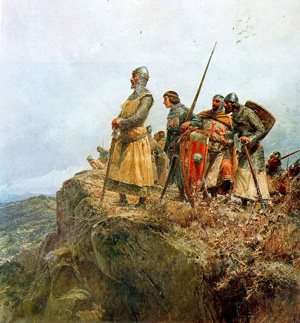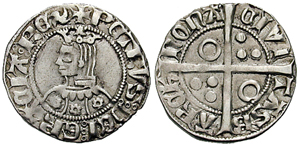Peter III was born in 1236 and was the oldest
son of James I 'the conqueror'. In 1262 he would marry Constance of
Hohenstaufen, daughter of Manfred of Sicily, which
 would form the
basis for his later claim to the throne of the Kingdom of
Sicily. In 1266 the family of Roger
of Lauria came to the court of Peter III following the death of
the baron at Benevento. Peter and Roger would form a strong friendship
that would last a lifetime. During this time Peter would sire
several children out of wedlock, including James
Perez who would become the archenemy of Roger of Lauria.
His father died 27th of July 1276 while putting down the mudéjars revolt and
Peter was crowned with Constance in November 1276 as king of the
Crown of Aragon and Count of Barcelona, which made him titular ruler of
Aragon, Catalonia and Valencia. Peter also renounced all feudal obligations to
the papacy which his grandfather Peter II had incurred, leaving him
free to confront the papacy and France over Sicily.
In what would prove later to be somewhat controversial, Peter named
John of Procida as his chancellor
and brought a number of other Sicilian refugees into the government,
including the Lancia family and Roger of Lauria.
would form the
basis for his later claim to the throne of the Kingdom of
Sicily. In 1266 the family of Roger
of Lauria came to the court of Peter III following the death of
the baron at Benevento. Peter and Roger would form a strong friendship
that would last a lifetime. During this time Peter would sire
several children out of wedlock, including James
Perez who would become the archenemy of Roger of Lauria.
His father died 27th of July 1276 while putting down the mudéjars revolt and
Peter was crowned with Constance in November 1276 as king of the
Crown of Aragon and Count of Barcelona, which made him titular ruler of
Aragon, Catalonia and Valencia. Peter also renounced all feudal obligations to
the papacy which his grandfather Peter II had incurred, leaving him
free to confront the papacy and France over Sicily.
In what would prove later to be somewhat controversial, Peter named
John of Procida as his chancellor
and brought a number of other Sicilian refugees into the government,
including the Lancia family and Roger of Lauria.
He first had to put down the revolt in Valencia, which he did by September 1277. He finished this affair only to be confronted with a revolt of Catalan nobles led by the Viscount of Cardona and the Counts of Foix, Pallas and Urgel. The revolt hinged on a dispute between the Moncada and Foix families over titles to land, but these were essentially excuses. Not until 1280 would Peter be able to settle the dispute and trap recalcitrant rebels in the castle of Balaguer in Urgel. After a month long siege the nobles surrendered and were thrown in prison for one year, with the exception of the ringleader, the Count of Foix, who was not released until 1284.
 The crushing of the revolt left Peter free to pursue his aquisition of Sicily.
After successfully invading Sicily in 1282
Peter would return to Aragon leaving Queen Constance
to rule in his place.
Peter returned to Aragon following his 'joust'
with Charles of Anjou and remained there to deal with the cortes
and the impending invasion of Catalonia by the French. When the
French invaded in 1285 he resorted to guerilla tactics to confront
the larger French force. Though he could not prevent the fall of
Gerona, when Roger of Lauria destroyed the French supplies at Rosas,
Peter and his brother Alfonso counterattacked and destroyed the French army at the
Battle of the Col de Panissars (picture above). Peter
was planning the invasion of Mallorca to punish his brother James of Mallorca
for supporting the French when he died on November 2, 1285 at Vilafranca del Penedès.
The crushing of the revolt left Peter free to pursue his aquisition of Sicily.
After successfully invading Sicily in 1282
Peter would return to Aragon leaving Queen Constance
to rule in his place.
Peter returned to Aragon following his 'joust'
with Charles of Anjou and remained there to deal with the cortes
and the impending invasion of Catalonia by the French. When the
French invaded in 1285 he resorted to guerilla tactics to confront
the larger French force. Though he could not prevent the fall of
Gerona, when Roger of Lauria destroyed the French supplies at Rosas,
Peter and his brother Alfonso counterattacked and destroyed the French army at the
Battle of the Col de Panissars (picture above). Peter
was planning the invasion of Mallorca to punish his brother James of Mallorca
for supporting the French when he died on November 2, 1285 at Vilafranca del Penedès.
Dante would speak highly of Peter, placing him before the Gates of Purgatory: "He who seems so stout of limb, Peter of Aragon,..., him of the prominent nose, was cinctured with the cord of every virtue." The Florentine chronicler Villani believed Peter was of excellent character, courageous and wise, a great warrior, and feared by both Christians and Saracens, "like no other king of his time". He was buried at the Monastery of Santes Creus and succeeded by his eldest son Alfonso III.

